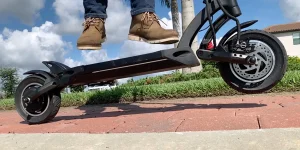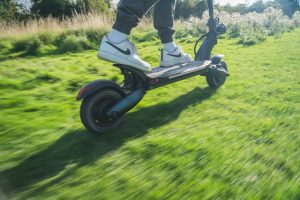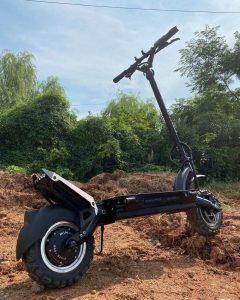Electric scooters can travel on gravel but require suitable models and care.
Introduction to Electric Scooters
Electric scooters have surged in popularity as a compact and eco-friendly mode of transport for urban commuting.

Types of Electric Scooters
There are several types of electric scooters, each tailored to specific needs and preferences:
- Commuter Scooters: Ideal for daily travel with features like foldability and moderate speed.
- Performance Scooters: Built for speed and range, often equipped with larger batteries and more powerful motors.
- Off-road Scooters: Designed with robust tires and suspension to handle rough terrains.
- Heavy-duty Scooters: Cater to heavier riders with sturdy frames and high weight capacity.
Basic Design and Functionality
The fundamental design elements of electric scooters include:
- Frame: Typically made of aluminum or steel for an optimal balance of strength and weight.
- Motor: Ranges from 250 to 2000 watts, directly influencing the scooter’s speed and torque.
- Battery: Commonly lithium-ion, providing an average range of 10 to 40 miles on a single charge.
- Brakes: Essential for safety, with options like disc brakes, drum brakes, or regenerative braking systems.
Popularity and Use Cases
Electric scooters have become prevalent due to their convenience and cost-effectiveness. Notable use cases include:
- Urban Commuting: A popular choice for city dwellers to avoid traffic jams and parking hassles.
- Tourism: Tourists rent electric scooters to explore new cities with ease.
- Delivery Services: Utilized by delivery personnel for quick and efficient parcel delivery.
Electric Scooters and Road Surfaces
The performance of electric scooters is significantly influenced by the type of road surface they travel on. Different surfaces can affect the traction, handling, and overall longevity of the scooter.
How Different Surfaces Affect Scooter Performance
Electric scooters, designed primarily for smooth asphalt, can encounter performance issues on less ideal surfaces:
- Asphalt: Offers optimal conditions with minimal resistance, allowing scooters to reach and maintain maximum speed and efficiency.
- Concrete: Provides a harder surface than asphalt, which may decrease comfort due to higher vibration levels.
- Gravel: Can reduce traction and stability, potentially leading to increased tire wear and reduced control.
Scooter Wheels and Traction on Various Terrains
The wheels play a crucial role in determining how well a scooter performs on different terrains:
- Wheel Size: Larger wheels, typically 8 inches or more in diameter, offer better stability on uneven surfaces.
- Tire Type: Pneumatic tires provide more cushion and grip, while solid tires have less maintenance but offer less shock absorption.
- Tread Pattern: Tires with deeper treads and more aggressive patterns are better suited for rough and loose surfaces like gravel.
Impact of Road Conditions on Scooter Longevity
The longevity of an electric scooter can be impacted by the road conditions it frequently encounters:
- Smooth Surfaces: Lead to less wear and tear, potentially extending the scooter’s lifespan beyond the average of 2 to 3 years.
- Rough Terrains: Increase the stress on the scooter’s frame and components, which may necessitate more frequent repairs and replacements.
Adaptability of Electric Scooters to Gravel
Electric scooters can vary greatly in their adaptability to gravel roads. Factors such as wheel design, motor power, and build quality all play critical roles in how well a scooter can handle gravel surfaces.
Scooter Models Best Suited for Gravel Roads
Certain electric scooters are better equipped for gravel roads due to their robust design and enhanced features:
- Robust Frame Construction: Scooters with a sturdy frame can withstand the vibrations and impacts of gravel roads.
- High Motor Power: Motors with higher wattage, typically around 500 to 1000 watts, provide the necessary torque for uneven terrains.
- Appropriate Wheel Size and Type: Larger pneumatic tires, usually 10 inches in diameter with off-road tread patterns, offer better traction and stability on gravel.

Modifications for Enhancing Gravel Road Capability
To improve an electric scooter’s performance on gravel roads, riders can consider the following modifications:
- Upgraded Tires: Installing off-road tires with a thicker tread can improve grip and reduce slippage on loose gravel.
- Suspension Add-ons: Adding or upgrading the scooter’s suspension system can absorb shocks and provide a smoother ride on bumpy surfaces.
- Protective Accessories: Fitting mudguards and protective plates can help shield the scooter from gravel and debris.
Limitations of Electric Scooters on Rough Terrains
Despite modifications, electric scooters inherently have limitations on rough terrains:
- Reduced Battery Life: The increased resistance of gravel can lead to quicker battery drain, reducing the typical range of 15-20 miles per charge.
- Increased Wear and Tear: Frequent travel on gravel can accelerate the wear on tires and mechanical parts, necessitating more regular maintenance.
- Lower Speeds: To maintain control and stability, riders often must operate at lower speeds, which can significantly extend travel time.
Safety Considerations
When riding electric scooters, especially on unpredictable gravel roads, safety should be the paramount concern.
Protective Gear for Riding on Gravel
Riding on gravel necessitates additional protective gear due to the increased risk of falls and injuries:
- Helmet: A full-face helmet provides the best protection against head injuries.
- Gloves: High-quality gloves protect the hands and improve grip.
- Elbow and Knee Pads: These are essential for shielding against scrapes and impacts.
Navigational Techniques for Gravel Roads
Effective navigational techniques are crucial for maintaining control on gravel surfaces:
- Weight Distribution: Keeping weight low and centered helps with balance.
- Turning: Slow down before a turn and avoid sharp maneuvers to reduce the risk of skidding.
- Speed Management: Maintain a consistent, moderate speed to ensure reaction time and control.
Emergency Handling and Accident Prevention
Being prepared for potential emergencies can significantly reduce the risk of accidents:
- Regular Maintenance Checks: Ensure the scooter’s brakes and tires are in optimal condition to respond effectively in an emergency.
- First-Aid Training: Knowing basic first-aid can be vital in the event of an accident.
- Ride Planning: Avoid riding in extreme weather conditions and plan routes with minimal gravel road exposure.

